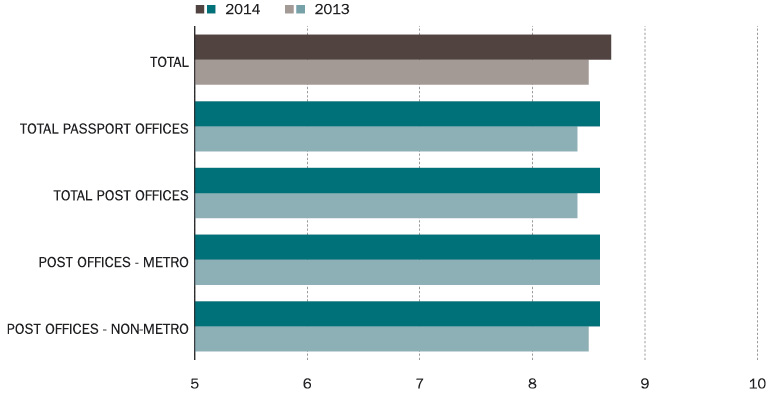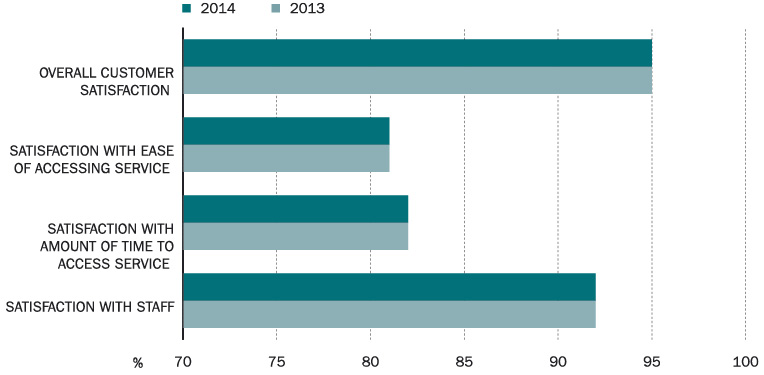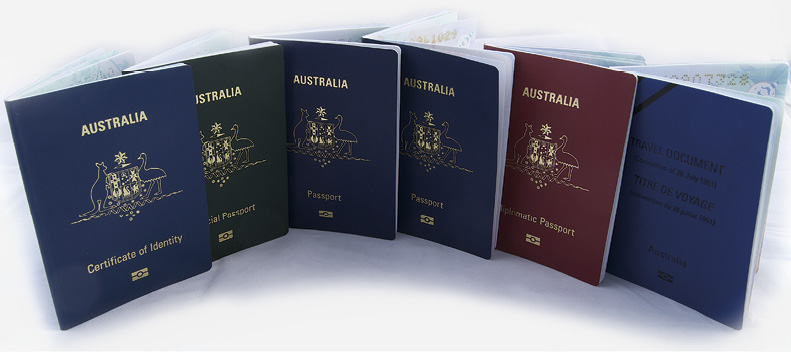Program 2.2: Passport services
| Objective |
|---|
|
To provide Australians access to secure international travel documentation through the delivery of high-quality passport services. |
| Deliverables | 2013–14 result | Reporting |
|---|---|---|
|
High-quality passport services to Australians, including processing new passport applications, registering lost or stolen passports, issuing emergency passports, and detecting passport fraud. |
met | below |
|
Maintenance of security standards, promotion of web-enabled services, and adherence to the client service commitment of passport issue within ten working days, while effectively managing an increasing workload. |
met | below |
|
Ongoing implementation of the National Security – Improved Passport Integrity and Strengthened Issuance Systems (Passport Redevelopment) program.* |
some progress | below |
|
Finalisation and production of the new P-series Australian travel document. |
met | below |
| Key performance indicators | 2013–14 result | Reporting |
|---|---|---|
|
Public and travel industry clients are satisfied with the department’s efficiency and effectiveness in delivering passport services, with routine passports issued within ten working days and urgent passport issues dealt with in a timely and responsive manner. |
met | below |
|
Staged delivery of the National Security – Improved Passport Integrity and Strengthened Issuance Systems (Passport Redevelopment) program within budget and against timelines.* |
some progress | below |
|
Introduction of the new P-series Australian travel document in mid-2014. |
met | below |
* The Portfolio Additional Estimates Statement 2013–2014 amended the Program 2.2 KPIs and Deliverables to clarify the title of the department’s program for the redevelopment of a new travel document issuance system.
Overview
Australia’s reputation for providing a world class passport was reinforced with the release of the next generation (P-series) passport—ahead of schedule on 16 June 2014. The new security features reflect the department’s strong focus on passport security.
The department provided a secure, efficient and responsive passport service to Australian citizens in 2013–14. We issued 1.8 million passports through a network of more than 1600 Australia Post outlets, nine Australian passport offices in Australia and over 100 Australian diplomatic missions and consulates overseas.
The department sustained strong client service performance, issuing passports within 10 working days in 98.6 per cent of cases. We assisted 177 clients affected by natural disasters to obtain a replacement passport free of charge.
Passport services
Despite weakening consumer sentiment in the second half of the year, we issued 1 803 143 passports in 2013–14, a 5.83 per cent increase on the previous year.
The bulk of our passports were produced in Australia while our missions and consulates overseas issued 7857 emergency passports and processed 90 044 ordinary passport applications.
The department issued 175 496 priority passports and met the two working day processing target in 99.5 per cent of cases. Three clients requested a refund of the priority processing fee where the service level was not met. There was a 9.76 per cent increase in priority applicants, which tracked the overall increase in passport numbers, but also reflected the value of this additional service to clients.
| 2011–12 | 2012–13 | 2013–14 | |
|---|---|---|---|
| TOTAL number of travel documents issued | 1,747,670 | 1,703,850 | 1,803,143 |
| % produced in Australia | 98.6 | 98.7 | 98.6 |
| % issued in 10 working days | 99.7 | 98.8 | 98.6 |
| Emergency passports issued by Australian diplomatic missions | 7,976 | 8,020 | 7,857 |
| Priority (PPF) passports issued | 157,820 | 157,112 | 175,496 |
| % of PPF passports issued in 48 hours | 99.8 | 99.8 | 99.5 |
| Documents reissued due to natural disaster | 275 | 74 | 177 |
The fee for an ordinary passport increased from $238 to $244 on 1 January 2014. This was in accordance with the Australian Passports (Application Fees) Act 2005 which provides for annual passport fee increases in line with the consumer price index.
Australia Post provided passport interviewing services through its national network of 1665 corporate and licensed post office outlets on behalf of the department. Australia Post conducted 94.7 per cent of passport interviews in Australia.
In 2013–14, 32.92 per cent of clients used the electronic passport application forms available online at www.passports.gov.au. This was consistent with last year’s usage. We continue to review opportunities to improve the passports website and increase client take-up of online services.
The Australian Passport Information Service (APIS) provided a phone information service to clients and arranged interviews with our passport offices in Australia on behalf of the department. APIS handled 1 819 842 enquiries, an increase of 7.3 per cent over 2012–13 levels.
During the year, 38 689 passports were reported lost or stolen (compared with 37 720 last year). As a percentage of total passports on issue, this is consistent with the annual rate since the introduction of lost and stolen fees in 2005.
The number of passports reported missing in the mail, following dispatch from our production centres, totalled 240 or 0.015 per cent. The department continues to work closely with Australia Post, including to investigate each instance individually, to minimise this number.
In 2013–14, the department reissued, at no cost, 177 passports to replace those lost, damaged or destroyed as a result of crises and disasters, including Typhoon Haiyan, Tropical Cyclone Dylan in Queensland and bushfires in Victoria and South Australia.
Delivering a contemporary passport service for Australia
The Australian Passport Office continued to work with the Information Management Division to progress work on the Passport Redevelopment Program (PRP). (See 3.1.)
Passport security
We began the phased implementation of the new P-series passport on 16 June 2014. Featuring an Australian-flag blue cover with gold embossing, the P-series passport builds on the already advanced security features of the Australian ePassport.
%20-%20Passport%20security.jpg)
Passport Officer, Rick Wellman, examines the ultraviolet features of the new P-series passport, 26 June 2014. [DFAT/Alan Walsh]
The department advanced the National Identity Security Strategy by promoting the Document Verification Service, combating identity crime, improving national management of death data and enhancing services to victims of identity crime.
As part of our efforts to strengthen national identity security, we played a leadership role in the national Facial Biometrics Centre of Expertise. The centre promotes collaboration and best practice among government agencies employing facial biometrics technologies. We commissioned world-leading research programs for facial biometrics with the Defence Science and Technology Organisation and the University of New South Wales. The department worked domestically and internationally to develop standards for facial comparison competencies and to have forensic facial comparisons recognised by Australian courts.
We finalised a memorandum of understanding with Taiwan for the exchange of lost, stolen and invalid passport data. We commenced work on changes to the Australian Passports Determination 2005 to expand Australia’s participation in the APEC Regional Movement Alert System. We worked with Interpol to improve the data we provide to its Stolen and Lost Travel Documents database.
We continued our work with the International Civil Aviation Organization (ICAO) to improve traveller security through the ongoing development of international standards for travel documents, the delivery of related capacity building efforts and the management and expansion of the ICAO. We also continued to actively participate in technical working groups with the International Organization for Standardization related to biometrics and passport chip technology.
We worked closely with other government departments to enhance border security and expand eligibility for the SmartGate automated border control system to other nationalities.
Fraud detection and prevention
The department worked closely with law enforcement and intelligence partners to detect, investigate and prosecute offences under the Australian Passports Act 2005. We became partners of the Australian Federal Police-led Fraud and Anti-corruption Centre and the National Border Targeting Centre strengthening our ability to advance national security.
We investigated 348 allegations of passport fraud involving identity or application fraud or the improper use or possession of an Australian passport. Forty of these cases were referred to the Commonwealth Director of Public Prosecutions. Passport fraud was proven in 25 cases prosecuted during 2013–14. The cases involved identity fraud, application fraud and improper use or possession of Australian passports.
The department increased its focus on high-risk identity fraud cases, including through improving our capacity to resolve complex identity cases with facial recognition expertise and facial matching technologies. We worked with other agencies to identify risk indicators and create a risk profile for persons attempting to obtain an Australian passport by using someone else’s genuine credentials. These efforts will increase our ability to detect passport applications using a fraudulent identity.
The Foreign Minister cancelled 77 passports under the Australian Passport Act 2005. This 62.5 per cent increase from the previous year was due largely to an increased number of requests from the relevant competent authority to cancel passports on national security grounds.
Client Services Charter
In accordance with our commitment to superior client services and the highest levels of security and integrity in the Australian passport system, the department commenced a review of Australian passports legislation. The review will assess redtape constraints while maintaining the integrity of the passport issuing process. We will ensure legislation continues to underpin the provision of an efficient and secure Australian passport system.
Client feedback on the department’s passport services and processes was positive. We conducted two client satisfaction surveys and will use comments from those, including in relation to the clarity of information on forms and supporting documents, to continually improve our services.
We responded to 84 passport related complaints, including as a result of internal reviews, investigations by the Commonwealth Ombudsman and claims under the Government’s scheme for Compensation for Detriment caused by Defective Administration (see also Section 3). The Commonwealth Ombudsman made no adverse findings against the department on passport related matters in 2013–14.
Figure 25: Overall satisfaction with passport application process (based on 1200 clients surveyed from late-March to mid-April 2014)

1 = Extremely dissatisfied10 = Extremely satisfied
Figure 26: Overall satisfaction with the Australian Passport Information Service (based on 3012 clients surveyed over a three-month period)

Outlook
Passport demand is expected to increase to 1.9 million in 2014–15. This is driven primarily by the increasing demand for children’s passports.
We will focus on maintaining—and looking for opportunities to enhance—our services to clients without compromising the integrity and security of the Australian passport system. We will finalise the review of the passport legislation.
We will address constructive client feedback and improve application forms and supporting documents, as well as information and services offered through the passports website at http://www.passports.gov.au.
Work on the PRP will continue.
We will begin design work on the next generation of travel documents, the R-series.

Australian P-series passports. [DFAT/Alan Walsh]

